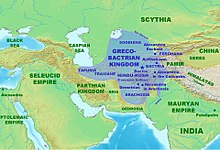Ariana (region)
Ariana (Greek Arianē, Latin Arianē, Latinized Ariana, literally: "Land of the Aryans") is a term that was mainly used by Greek and Roman geographers for a historical region between Persia and India. Eratosthenes referred to the inhabitants of Ariana as "Aryans". Diodorus also mentions that Zarathustra Ahura Mazda's laws are said to have preached to the "Arianoi" (inhabitants of Ariana). The historical area roughly corresponds to the whole of today's Afghanistan , as well as parts of today's east of Iran .
etymology
The Greek term “Arianē” (Latin: “Ariana”) is based on the Avesta term “Airiiana-” or Airyanem Vaejah , the name of the motherland of Zoroastrianism and the “Aryan” peoples. The Greeks referred to Haroyum / Haraiva ( Herat ), one of the provinces of Ariana in what is now western Afghanistan, also as "Aria".
The roots of the term Ariana and its inhabitants Aria (Aryans) can be traced back to those of the Indo-Iranian term Aryans .
Geography of Ariana
The exact boundaries of Ariana are presented differently in classical sources, as there was often confusion with the province of Aria , which only makes up part of the entire Arianas. As a geographical term, Ariana was introduced by Eratosthenes and, according to him, is defined by the following provinces: Arachosia , Aria , Karmanien , Gedrosien , Drangiana , and Paropamisaden . In Apollodor von Artemita's definition, Bactria is also a part of Ariana and is referred to by him as the "ornament of Ariane as a whole". The most detailed description of this region was written by Strabo .
Strabo's definition is roughly similar to that of Eratosthenes, with the only difference that Strabo's Bactria and Sogdia are included in Ariana. A detailed description of Ariana can be found in Strabos Book XV - "Persia, Ariana, India", Chapter 2, Sections 1-9.
Religion in Ariana
The provinces of Aria , Arachosia and Drangiana (today's West and South Afghanistan) were mainly Zoroastrian . Above all, the area of Arachosia is said to have played a very important role in the development of Zoroastrianism. The Avesta first came to Persis through Arachosia, which is why some call it the "second fatherland of Zoroastrianism".
literature
- Horace Hayman Wilson, Charles Masson, Ariana Antiqua: a Descriptive Account of the Antiquities and Coins of Afghanistan , 1841
- Gnoli Gherardo. The idea of Iran. An essay on its origin , 1989
- Henry Walter Bellew, An inquiry into the ethnography of Afghanistan , 1891
- Tomaschek in Pauly-Wissowa, II / 1, cols. 619f., And 813f.
- G. Gnoli, Postilla ad Ariyō šayana, RSO 41, 1966, pp. 329-34.
- P. Calmeyer, AMI 15, 1982, pp. 135ff.
Individual evidence
- ↑ Pliny the Elder , Naturalis Historia , book vi, page 23
- ^ Ariana Antiqua: A Descriptive Account of the Antiquities and Coins of Afghanistan Book by Horace Hayman Wilson, page 119
- ↑ Ed Eduljee: Haroyu, Aria / Airan, Herat & Zoroastrianism . Retrieved May 17, 2020.
- ↑ Ed Eduljee: Aryan Homeland, Airyana Vaeja, location. Aryans and Zoroastrianism . Retrieved May 17, 2020.
- ↑ R. Schmitt: Aryans . Encyclopaedia Iranica. 1987. Retrieved May 17, 2020.
- ↑ Strabo 11.11.1
- ^ Strabos Book XV - Persia, Ariana, India . penelope.uchicago.edu. Retrieved May 21, 2020.
- ^ Gnoli Gherardo .: The idea of Iran. An essay on its origin . S. 133 .

